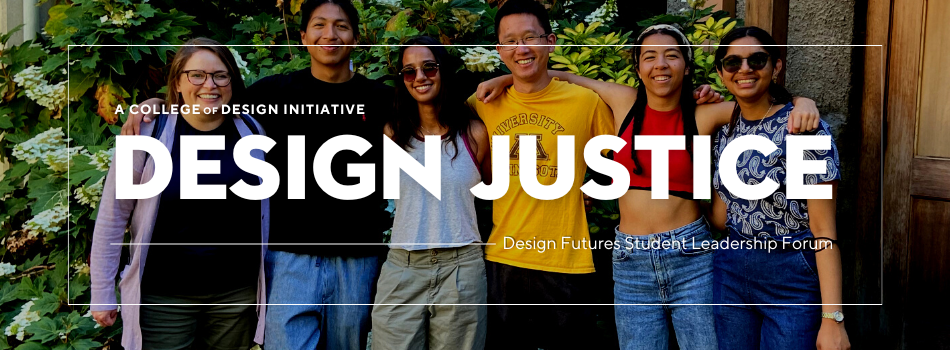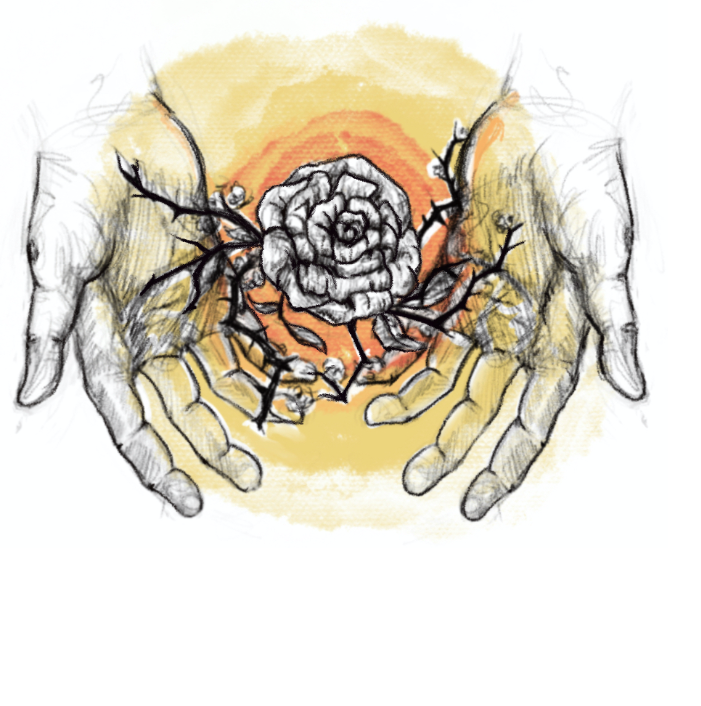
2024 Design Futures Forum
The Design Futures Student Leadership Forum in-person convening will be held at the Washington University in St Louis on Monday, May 20-24, 2024. Accepted applicants will be accommodated to attend the forum (meaning that the College of Design will pay for your airfare, room/board, breakfast, and lunch), and will be met with 70+ student leaders from across the nation representing design programs from leading academic institutions and over 25 academic and practitioner faculty from private and non-profit based practices.
Interested CDES major/minor students are asked to apply by Saturday, April 1st. Applications will be reviewed and applicants will be notified of acceptance by April 14th. To view previous years, visit www.designfuturesforum.org.
2023 Design Futures Forum Recap

This year's forum took place in Eugene, Oregon at the University of Oregon. The student cohort included Audra Sims, Neha Shyam Aramkuni, Miska Abdel-Magid, Dakota Santillan, and Timothy Follett-Dion. The two accompanying faculty were Jessica Garcia-Fritz and Terresa Moses.
Welcome Opening Circle
- Audra: Before jumping into the topics of learning for the week, the Forum facilitators established a Community Agreement, a standard list of rules that would ensure we create a respectful and open environment for others. We were also asked several questions that would open our minds to interacting with each other and the learning material. Looking back, the questions asked now only put the group of designer’s into a state of ideation and creativity, but also altered how we would interact with the following lectures – from a more dynamic mindset, rather than stagnant.
- Miska: The very first group meeting we had was a talk and activity led by Ezra Kong. Ezra led the discussion of what the week would look like in terms of the workshops, activities, food and rest. They established a community agreement which was created to allow all the attendees to have fun, learn from each other, and most importantly, listen to your body and take care of yourself accordingly. Then we were asked a series of questions to reflect on our past experiences and desires from the conference. Our responses prompted discussion with other members of the group.
- Neha: Ezra Kong, the lead of the event walked us through what the week was going to look like set some rules and boundaries down so that we would be open to learning but also make sure that we prioritize ourselves and not burn ourselves out.
- Dakota: The first day of the student meeting we met in an outdoor area where we were able to interact and meet the other students from the other attending universities. We had a great welcome from the University of Oregon.
- Tim: Ezra Kong, the one of the organizers from the University of Oregon, was welcoming us. They went through all the information and created a safe environment for us to chat and connect.
On This Site by Bernadette Onayaka & Jess Zimbabwe
- Audra: Design has continuously served white people, and continues to serve in their favor. Both indiscreetly and discreetly, POC continue to be displaced and divided into inhumane living conditions. Large developments continue to cater towards wealthy clientele, bulldozing already inhabited land and displacing families. These living discrepancies not only continue to be forced, but have been long established through the malevolent act of redlining. Redlining was historical allocation of resources and wealth to perceived “safer” and more “valuable” neighborhoods: of which the defining factor was the segregation lines that it formed. Through blacklisting predominantly colored neighborhoods – and providing less resources – class lines continued to deepen. Although redlining is now illegal, that does not prevent realtors from enacting discriminative practices. The designer’s relevancy in this oppression is not one of action, but of inaction and complicitness. There is still a role that the designer has, creating the environment – and with a role, there is still the ability to impact.
Insider/Outsider: Identity, Intersectionality, and Imagination by Khalilha Haynes, Rajan Hoyle
- Neha: We discussed the different -isms present and if we are privileged or not in said isms.
- Miska: In this core workshop, the presenters began with a lecture on forms of oppression. We were taught to understand them through this sentence: Sexism: the belief in the inherent superiority of one sex over all others and thereby the right to dominance. The underlined word can then be interchanged with other words including race, age, class, ability, etc. We then filled out a worksheet addressing the ways that we are individually oppressed or privileged. Then we joined groups to discuss the ways in which designers can accommodate each ism in order to create a more equitable society.
- Dakota: In this core session, we had the opportunity to listen and learn a little more in depth about the different ways that people are privileged. Some of these privileges are very noticeable, such as social class, but there are many others that we forget exist. We were placed into groups and proceeded to the activities in which we had the chance to see back into our identities and privileges.
- Tim: In this core session, we have the opportunity to listen and speak the inside and outside story in the design field. We have the opportunity to divide into different groups and touch on different challenges that block people from having an equal opportunity. At the same time, we got to hear different people story and able to connect each others feeling.
- Audra: Insider/Outsider focused on the intersection of identity and design. For a long time, identities perceived as “different” have been left out of design and the phases of creating designs. Through our own experiences – and this core session – we learned about how all aspects of design should be open to all aspects of identity.
From Awareness to Action: Integrating Trauma-Informed Engagement Strategies by Eric Riley, Robert Douglass, and Ellen Epley
- Miska: In this workshop, we learned about different forms of trauma responses. We discussed how to design with communities instead of for them. We learned a series of techniques used to establish a trusting relationship between designers and the community they are designing with.
- Tim: Trauma, almost everyone gets to experience during sometime of their life. Design becomes not only about self ego, but to design to solve a community trauma and healing.
- Audra: Trauma has played an invisible role in impacting and providing for communities. Through Awareness to Action, we learned about how trauma may affect communities that we are aiming to help, and what practices to use in order to create a more efficient design. When interacting with a community that you may be designing with, it is important to consider their need for safety, belonging, and dignity.
Racism Untaught: From Theory to Practice by Lisa Elzey Mercer and Terresa Moses
- Miska: In this workshop, we discussed some of the ways white supremacy shows up in our everyday lives, especially in work settings. We did activities which helped us understand the ways that we show up in society in terms of our privilege and oppression, and how we can relate to one another and show up for each other as humans first and coworkers second.
- Audra: Racism Untaught pushed us into seeing the imperceptible ways that racism can present itself both within structural institutions and within ourselves. We alternated between the external and internal ways of racism, and even investigated how some of our identities may present us with certain privileges. As we searched inside ourselves, we were encouraged to write an “ethics code” that would begin to rewrite some of our tendencies and beliefs that perpetuated racism and white supremacy.
Indigenized Planning Solutions: From Landscape Design to Equitable Urban Housing Policy by Genevieve Middleton
- Dakota: Perhaps the presentation that touched me the most, Genevieve Middleton explained a large, and unconventional, trajectory in architecture and urban planning in which she acquired the skills fields of study and work. She carried out a focused multiple housing project in which the design is the product of an investigation of culture, aesthetics, lifestyles and the needs entail for an indigenous community. This architectural project becomes, for me, a very special world since it focuses on a reconstruction and decolonization of architecture as we know it, making reference to vernacular architecture.
Equity Centered Community Design: Defining and Assessing Communities Needs by Robert Beckles and Dhara Shah
- Miska: In this workshop we talked about designing based on equity rather than equality. We discussed how to define and assess the community’s needs before beginning to design with them. We thought about all the individuals involved in designing with a community and how their power and privilege affect decision making within designing.
- Neha: Additionally it was empasised that you are not designing for communities, you are designing with them.
Put Your Roots Down: Land-Based Healing and Design Practices by Shalini Agrawal and Almas Haider
- Dakota: On this day we were able to go out and enjoy an outdoor session in the nature of the university. It was a very energetic experience where we reflected on the lack of feeling connected to nature and, therefore, forgetting our roots.
- Tim: In this workshop, we were able to go out and connect with nature. We sit, listen, watch, and smell what nature has to offer. In the end, we will be put of the apart.
Community-Based System Dynamics: An Experiential Introduction to a Participatory Approach for Systemic Change by Kelsey Werner and Christina Warrine
- Neha: CBSD is based on cause-and-effect relationships. A lot of actions can have a cyclic effect.
- Audra: System Dynamics taught us about the approach to understanding the feedback structure which creates system behavior. Through a group project of creating our own system dynamics models, we were able to depict, share, and negotiate, our understanding of system behavior.
Reflections

A piece inspired by Trauma-Informed Engagement Strategies by Audra Sims





